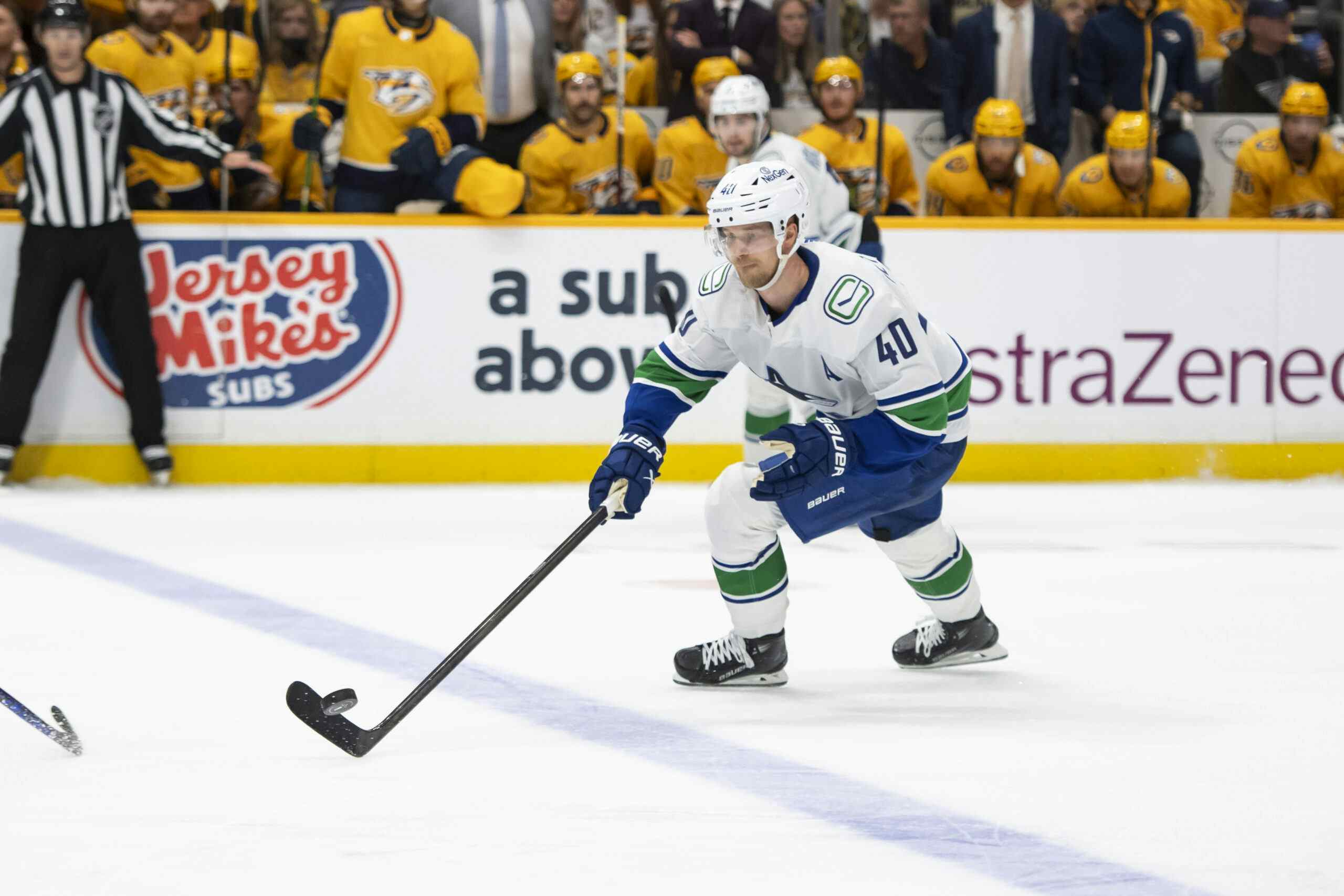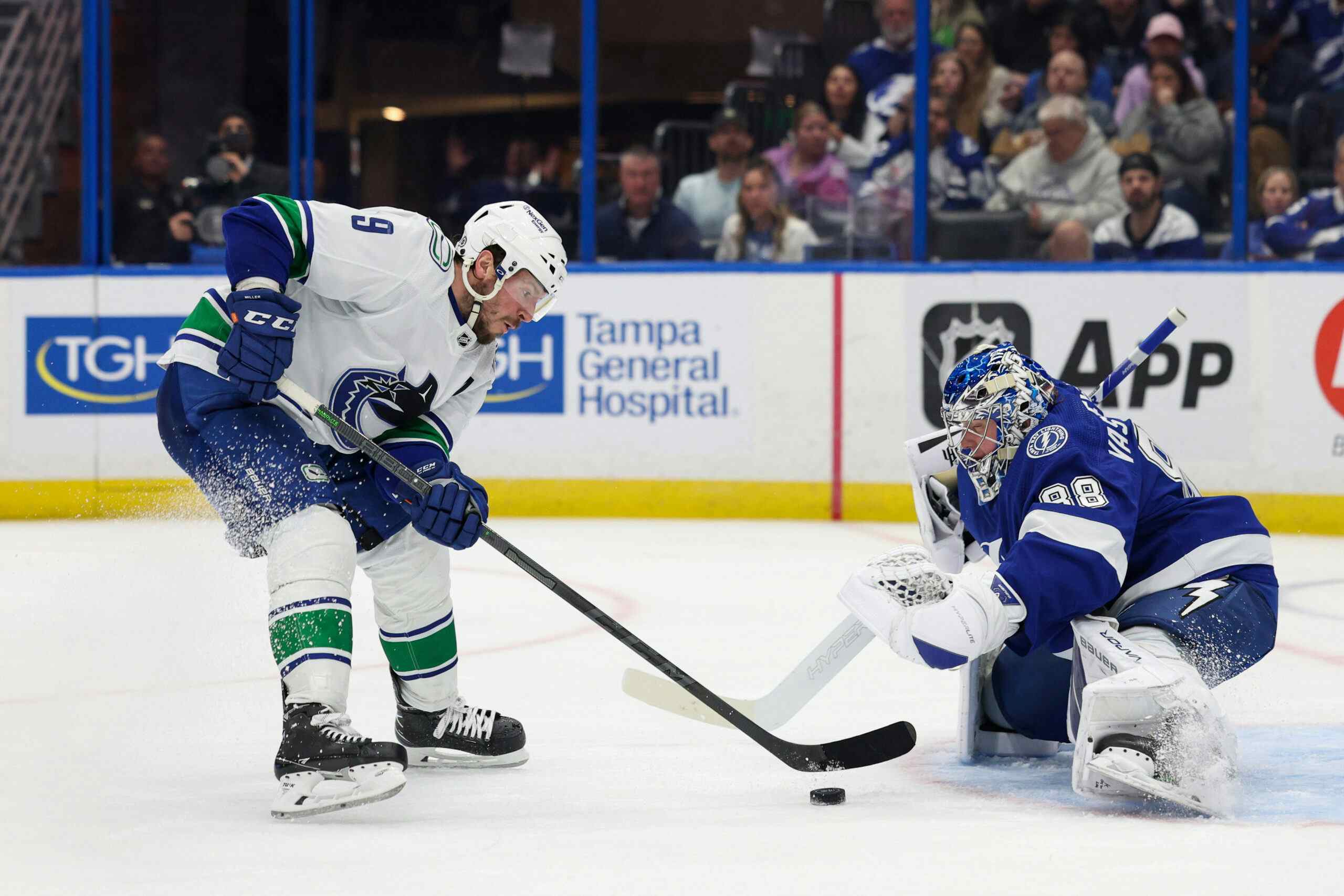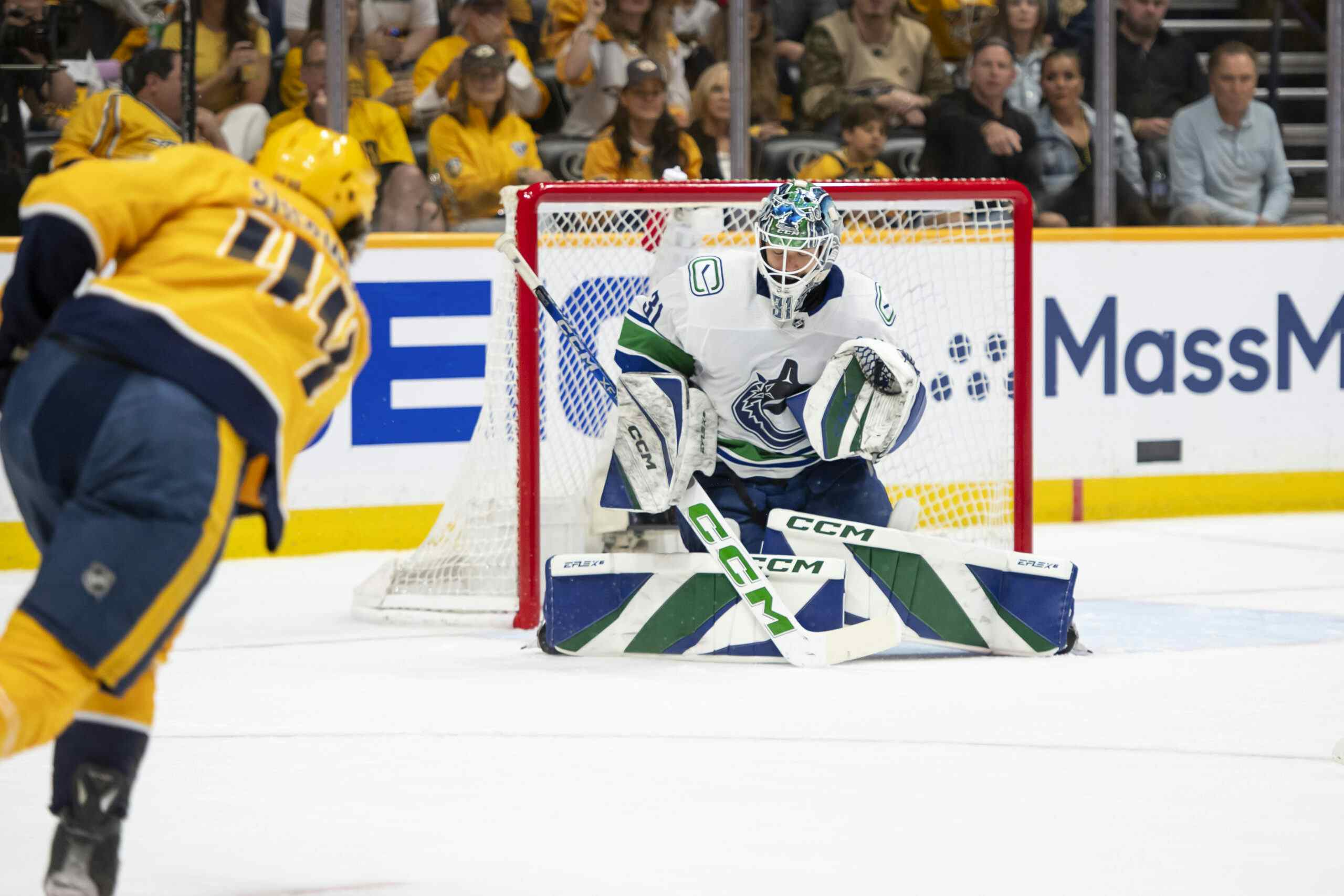Canucks Army Pre-Season Prospect Rankings: #9 Jordan Subban

6 years ago
Christopher Nolan’s Inception may have been overrated, overlong, and overwrought*, but it did brilliantly articulate a truth about the human mind: The simplest idea, if implanted in the subconscious mind, can wreak havoc on a person’s ability rationally perceive their surroundings.
It also gave me what is, to date, my only theory as to why the discussion around Subban as a prospect has unfolded in the manner it has since he was drafted with the 115th overall pick in the 2013 NHL Entry Draft. The tone of the coverage Jordan Subban has received within the city of Vancouver defies the realm of the physical, of what our simple understanding of the universe considers to be possible. That leaves us searching for an answer that borders on the metaphysical, and I have the Nolan brothers to thank for it.
One night, likely in late 2013 or early 2014, Leonardo DiCaprio, Joseph Gordon-Levitt, Tom Hardy, and co. implanted themselves deep within the subconscious minds of a variety of influential members of Vancouver’s media class, (and, apparently, a few Redditors,) and whispered these words in the void:
“You only care about Jordan Subban because of his last name. If he weren’t PK’s brother, no one would be interested.”
It’s the only thing that explains how consistently bizarre, and to be frank, wrong many of the talking points surrounding Jordan Subban have been. This idea (among others) has been implanted so deep within our collective subconscious that it’s deeply affected our ability to distinguish truth from fiction.
I can’t speculate as to who would do such a thing or for what nefarious purpose, or whether or not it constitutes tampering under NHL by-law 15. What I do know is that if someone doesn’t set the record straight soon, we’re going to have members of the Vancouver sports commentariat throwing themselves off buildings while shouting things like “Why don’t they just convert him to forward?”
Jordan Subban clocks in at #9 on our countdown of the Canucks best prospects.
Qualifications
We’ve changed the qualifications up just a little bit this year. Being under the age of 25 is still mandatory (as of the coming September 15th), but instead of Calder Trophy rules, we’re just requiring players to have played less than 25 games in the NHL (essentially ignoring the Calder Trophy’s rule about playing more than six games in multiple seasons).
Graduates from this time last year include Brendan Gaunce, Troy Stecher, and Nikita Tryamkin, while Anton Rodin is simply too old now, and Jake Virtanen is not being considered solely as a result of his games played.
Scouting Report
Failed to load video.
Before we get into the gritty details, I’d just like to extend my sincerest gratitude to everyone who made it through my long, rambling homage to a seven-year-old blockbuster that most people (rightly) struggled to understand even as they were watching it.
Writing about prospects is hard, and giving any worthwhile analysis is even more difficult. That’s why a lot of what’s been said about Subban is somewhat understandable. He’s complex. But if we’re completely honest, a lot of what’s been said about Jordan Subban by both defenders and detractors is only slightly less ridiculous than “the cast of a multi-million-dollar Warner Bros. production re-arranged the structural integrity of my amygdala.”
I think what so many people don’t understand about Jordan Subban is that he’s incredibly offensively gifted. That’s something that the numbers bear out, and that you can verify with your own eyes. Other than Jesse Puljujarvi, I found Jordan Subban to be the most immediately noticeable player at last summer’s YoungStars tourney. When he was at his peak, he was capable of looking every bit like his older brother’s offensive equal. As an admitted outsider to the world of hockey jargon, I don’t possess the linguistic ability to describe the way he looks at the top of his game, but at times he almost looks like he’s hovering an inch or two of the ground when he carries the puck up the ice.
From a numbers perspective, Subban has always been well above the calibre of what would be expected from a former fourth round pick. Among qualifying AHL defenders under the age of 22, only four scored at a higher point-per-game pace than Subban: Ryan Pulock, Kyle Wood, Julius Honka, and Vince Dunn, all of whom are now considered blue-chip prospects if they weren’t at the time they were drafted.
I described Jordan Subban as immediately noticeable, but being noticed isn’t automatically a good thing, and Subban often draws attention to himself for the wrong reasons. As somebody who juggles 4 or 5 other creative endeavours as well as Canucks Army, I don’t get many chances to watch the Comets play, so I’ll refer to what Jeremy Davis had to say about Subban’s defensive play in Subban’s midterm prospect profile:
Which brings us to our other frequently asked question: how bad can he be in his own zone?The answer, unfortunately, is pretty bad. Subban struggles in multiple areas of defensive play, including position, board battles, gap control, and decision making under pressure. Given time, he can race the puck through all three zones, or make a 60-foot tape-to-tape pass. But when forecheckers bare in on him, he can have trouble making the simplest of plays.Even while on the power play while charged with leading the breakout, this has been an issue. As a result, he was often saddled with a second defenceman on the power play, in spite of Travis Green’s preference for four-forward units.These types of mental errors have notably decreased since the beginning of the season, but even so, they are evidence as to why I’m been supportive of the Canucks keeping him in the minors while he irons out these issues. Even now, getting through a whole game without an facepalm-inducing giveaway is a recognizable achievement – which should tell you how far he’s had to come in that regard.
That’s not exactly a ringing endorsement. I’d like to think Canucks Army has done a pretty good job of poking holes in traditional hockey narratives, but in this case, the old school guys are more or less correct. In his own zone, Subban’s a work in progress.
The funny thing about Subban is that he has a knack for confusing even his most fervent defenders. In a late-season edition of The Provies, the usually spot-on Jason Botchford discussed Jordan Subban, and how he was passed over for an injury call-up in favour of the much more boring (but still very good) defender Evan McEneny:
One of this season’s great mysteries remains Subban and how he didn’t get games, despite a Canucks defence which was healthy for about two weeks.Total.Before the season, Benning vowed if Subban kept improving his defensive game, he’d get his taste.Subban did in fact improve his defensive game. He did not get that shot in the bigs.The undrafted McEneny, however, did.This isn’t to take anything away from McEneny, a great story who had a nice season with one great offensive run. He became one of Travis Green’s most trusted defencemen, someone he’d use in any situation.But I found it very interesting the raw data suggests McEneny and Subban may have had identical seasons at even strength.In fact, it may have been Subban who was the better defenceman.Subban’s relative goal stats have been better, but it’s McEneny who has the reputation as the responsible d-man, and the one good enough in his own zone to get him some NHL action.It’s Subban who gets snubbed all season despite improving defensively, despite quality even strength data behind him and that evidence he carries his pairing partner while McEneny did not.And there’s this:He’s really good on the power play and the Canucks are, well, not.You ever think that maybe all the people who believe Subban is a tire fire in his own end are …. wrong?
The data that Botchford is referring to here is basically on ice goal-differential. Both Subban and McEneny were 50% GF% players at 5-on-5 at the time the piece was written. Subban, however, had a slight edge in terms of relative GF%.

There’s been a desire among the people in this market that desperately want to see Subban play to find something- anything– that would point to the concerns about his defensive play being overblown. Unfortunately, in this case, where there’s smoke, there’s fire. GF% isn’t a great predictive metric, and a 5% swing in relative goals isn’t really large enough to draw any strong conclusions.
That doesn’t mean Botchford’s point isn’t without merit, though. Subban may be an adventure in his own end, but he was also a positive GF%rel player at 5-on-5 this year. Even if he’s turning the puck over on a constant basis, it hasn’t resulted in his team being outscored relative to his teammates. That’s an important bit of context, because it indicates Subban’s offensive capabilities may be enough to make up for the areas in which he struggles. More importantly, his contributions on the man advantage are enough to make him a net positive for his team, at least at the AHL level.
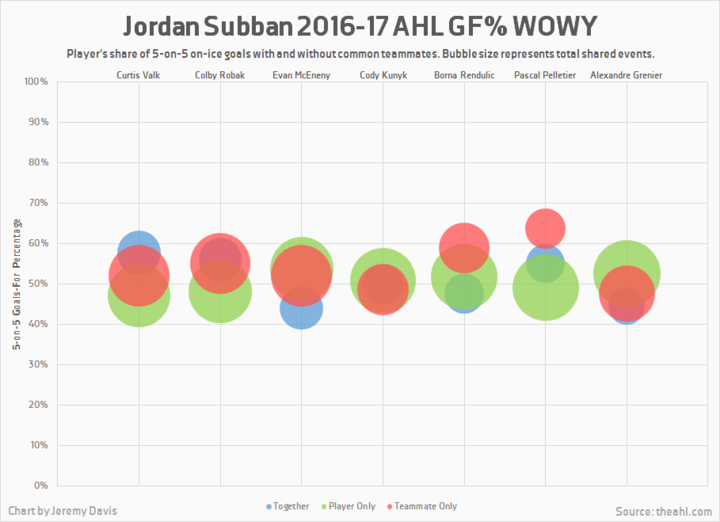
Subban’s stock has taken a bit of a hit, even around here, but that’s almost entirely due to the talent the Canucks have added since the 2017 trade deadline. No less than five of the prospects ahead of Jordan Subban on this list weren’t in the system the last time we did our prospect rankings. That’s an insane haul for only half a year’s time, and to be completely honest, if not for the sweet siren’s song of recency bias, Subban would probably be a few slots higher on our consensus ranking.
Draft analytics paints a somewhat underwhelming picture of Jordan Subban, who now carries an expected success percentage of just 14.1%, down significantly from the numbers he’s posted in previous editions of our prospect rankings. Out of six matches, Subban’s only successful cohort was Andrew Ference.
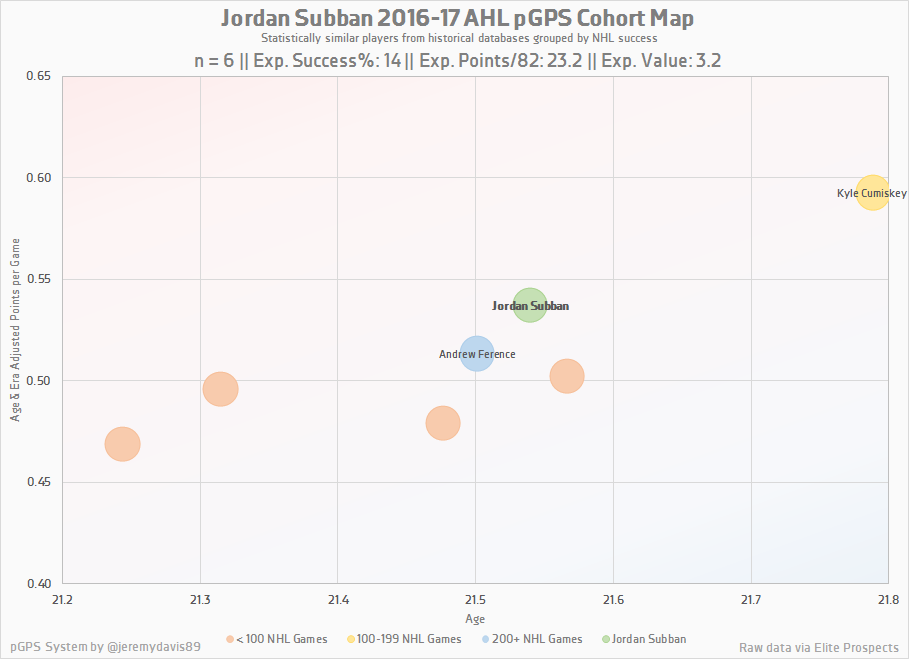
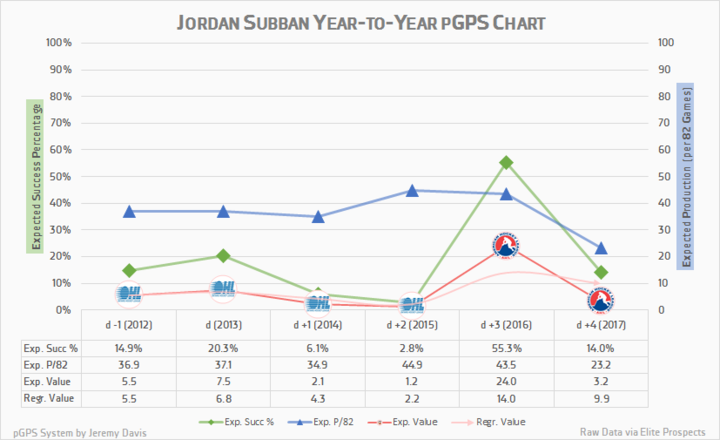
It should be worth noting that pGPS can be volatile, and Subban has fallen victim to this in a manner worse than most of his peers. Just a short time ago, he carried an expected success percentage above 50% and counted Sami Vatanen and Torey Krug among his successful cohorts.
Subban’s been talked about so much in this market that it’s easy to forget he only just completed his second year of pro hockey. He’s still only 21-years -old, and plays a position that’s notoriously difficult to master.
One of the most frequent questions I get about prospects is a variation of “If player X and player Y are virtually the same age why are you willing to write off one, but not the other?” In this market, Jake Virtanen is a frequent example. Some of you reading this may even be wondering why so many writers at Canucks Army seem willing to draw strong conclusions about Jake Virtanen but not Jordan Subban, who is one year his senior. The answer lies in the concept of ceiling, and our ability to predict a player’s likely value based on their scoring pace.
In Virtanen’s case, we more or less knew that, barring an unforeseen jump in production (which is always possible), his most likely career outcome was that of a bottom-six or replacement-level player. Even Jake’s most fervent defenders now seem to agree that the biggest question about Virtanen isn’t about how likely he is to be a high-end offensive player, but about whether or not he can carve out a role as a utility player in the NHL.
Subban is different. “Boom-or-bust” is an overused term when it comes to prospects, but in this case, it applies. Subban has proven at every level that he can put up the kind of numbers that point towards a good chance of being an NHL contributor. You can’t teach offense, and Subban has it in spades. Defense, on the other hand, is a discipline. It can be learned, and practiced, but it takes time. A little patience could go a long way. The question is whether or not Subban can put it all together.
Even if you take the bad with the good, I think there’s still reason to be optimistic about Jordan Subban’s chances of making an impact on an NHL roster someday. Given the way the Canucks’ brass has spoken about him in the past, I’m less optimistic that it will be in Vancouver.
BONUS TALK: Moving Subban To Forward
I reserved this profile ages ago, mainly as a way of airing my grievances with a number of ideas that have been bandied around this market for the past few years. So, in the spirit of self-indulgence, this profile wouldn’t be complete without exploring one last monumentally stupid idea.
Perhaps the most weirdly persistent myth about Jordan Subban is that he should be moved to the wing. In fact, that idea is even more widespread than I had originally thought.
Maybe it’s just a twitter thing?




Never mind.
So, since this idea is so popular, it must have some merit, right?
No. No. God no. Kill it with fire.
This was rather elegantly covered by Jeremy in the midterm prospect profile, which I highly recommend to anyone who’s interested in further reading on the subject. But just for the purpose of finally putting this notion to bed, I’ll give my take on the subject.
There are so many reasons why this line of thinking doesn’t make any sense when any level scrutiny is applied. First of all, the idea that offense and defense are two separate elements of the game is incredibly facile. Defensemen aren’t solely tasked with preventing the opponent’s attack and defending the blue line any more than forwards are solely tasked with playing beyond the red line. The assumption that Subban’s defensive deficiencies will somehow be diminished at forward really shows how little some fans understand about what makes him effective.
Subban’s greatest skill, by far, is his skating, and his ability to lead a breakout. Moving him up the ice only serves to mute that ability. By the same logic, any defensive forward would be better served playing on the back end. It makes absolutely no logical sense, and yet the idea continues to permeate the discourse surrounding the Canucks’ prospect pool.
It also presupposes that moving someone from the position at which they’ve played for the majority of their hockey playing career is something you can just do at the drop of a hat. Sure, it worked for Brent Burns and Dustin Byfuglien, but they are truly elite players. I think the world of Subban, but he simply isn’t that. The next time you hear somebody bring this up, take it as an invitation to tune out. It’s a very good indicator that the person you’re speaking to has no idea what they’re talking about.
*Author’s Note; I actually didn’t mind Inception, but damn if it wasn’t longer, more confusing, and more hyped than it ever needed to be.

